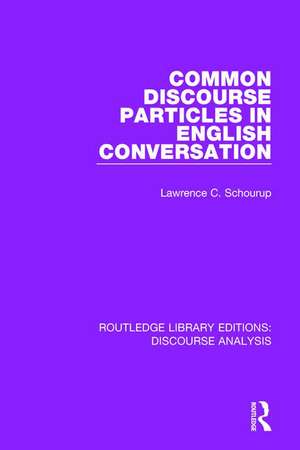Common Discourse Particles in English Conversation: RLE: Discourse Analysis
Autor Lawrence C. Schourupen Limba Engleză Paperback – 17 mai 2018
| Toate formatele și edițiile | Preț | Express |
|---|---|---|
| Paperback (1) | 369.63 lei 43-57 zile | |
| Taylor & Francis – 17 mai 2018 | 369.63 lei 43-57 zile | |
| Hardback (1) | 680.31 lei 43-57 zile | |
| Taylor & Francis – 2 noi 2016 | 680.31 lei 43-57 zile |
Din seria RLE: Discourse Analysis
-
 Preț: 371.57 lei
Preț: 371.57 lei -
 Preț: 358.35 lei
Preț: 358.35 lei -
 Preț: 358.35 lei
Preț: 358.35 lei -
 Preț: 318.44 lei
Preț: 318.44 lei -
 Preț: 317.68 lei
Preț: 317.68 lei - 34%
 Preț: 3492.06 lei
Preț: 3492.06 lei -
 Preț: 238.04 lei
Preț: 238.04 lei -
 Preț: 318.23 lei
Preț: 318.23 lei -
 Preț: 316.50 lei
Preț: 316.50 lei
Preț: 369.63 lei
Nou
Puncte Express: 554
Preț estimativ în valută:
70.73€ • 74.04$ • 58.52£
70.73€ • 74.04$ • 58.52£
Carte tipărită la comandă
Livrare economică 07-21 aprilie
Preluare comenzi: 021 569.72.76
Specificații
ISBN-13: 9781138224803
ISBN-10: 1138224804
Pagini: 188
Dimensiuni: 156 x 234 x 10 mm
Greutate: 0.29 kg
Ediția:1
Editura: Taylor & Francis
Colecția Routledge
Seria RLE: Discourse Analysis
Locul publicării:Oxford, United Kingdom
ISBN-10: 1138224804
Pagini: 188
Dimensiuni: 156 x 234 x 10 mm
Greutate: 0.29 kg
Ediția:1
Editura: Taylor & Francis
Colecția Routledge
Seria RLE: Discourse Analysis
Locul publicării:Oxford, United Kingdom
Cuprins
Preface; List of Symbols; 1 Introduction; 1.1 General Remarks 1.2 Covert Thinking in Conversation 1.3 Three ‘Worlds’ of the Speaker 1.4 Routinization 1.5 Use of speech Materials 1.6 Outline of Remaining Chapters; 2 Evinces; 2.1 Interjections and Evincives 2.2 Evincives in Quotations 2.2.1 ‘Well’ and ‘Oh’ in quotations 2.3 Enquoting 2.4 Quotation 2.5 Summary; 3 ‘Like’; 3.1 ‘Like’ in conversation 3.2 ‘Like’ Introducing Direct Discourse 3.3 ‘Like’ After Questions 3.4 The ‘For Example’ Use 3.5 ‘Like as an Interjection 3.6 ‘It’s Like’ 3.7 conclusion; 4 ‘Well’; 4.1 Introduction 4.2 ‘Well’ Before Exclamations 4.3 ‘Well’ Introducing Direct Discourse 4.4 Topic Shifting 4.5 ‘Well’ Before Answers 4.6 ‘Well’ Before Questions 4.7 ‘Well’ and Self-Repair 4.8 ‘Well’ and Other-Repair 4.9 Sentence-Final ‘Well’ 4.10 Reduced ‘Well’ 4.11 ‘Well’ and Narrative Elision 4.12 ‘Well’ and ‘Intension’ 4.13 Conclusion; 5 ‘You Know’; 5.1 Preliminary Remarks 5.2 YK as a Truth Parenthetical 5.3 YK and Properties of Truth Parentheticals 5.4 Evidence for two Types of YK 5.5 The Use of YKb 5.6 A Third YK? 5.7 Discourse Functions of YKb 5.7.1 Topic Introduction 5.7.2 Topic Tracking 5.7.3 YKb and Repair 5.8 YKb as a ‘Sociocentric Sequence’ 5.9 Interrogative YK 5.10 YK and Turn Taking 5.11 Distribution of YK: Some Quantitative Results 5.12 Conclusion; 6 The Role of Discourse Particles in Conversation; 6.1 General Remarks 6.2 ‘Now’ 6.3 ‘I Mean’ 6.4 ‘Mind You’ 6.5 ‘Sort O(f)’, ‘Kind O(f)’, ‘An(d) Stuff’, ‘An(d) Everything’, ‘An(d) so on’, etc. 6.6 Interjections 6.7 Types of Disclosure Functions 6.8 General Summary; Footnotes; References
Descriere
First published in 1985, this book studies several common items in English conversation known variously as ‘discourse particles’, ‘interjections’, ‘discourse markers’, and, more informally, ‘hesitations’ or ‘fillers’. While the analysis primarily focuses on ‘like’, ‘well’ and ‘you know’, the larger concern is the entire set of items of which these are members and as such ‘I mean’, ‘now’, ‘oh’, ‘hey’, and ‘aha’ are also examined. These discourse particles are analysed at length and then a framework is proposed in which their use individually makes sense and allows revealing comparisons to be made between them. This book will be of interest to students of linguistics
